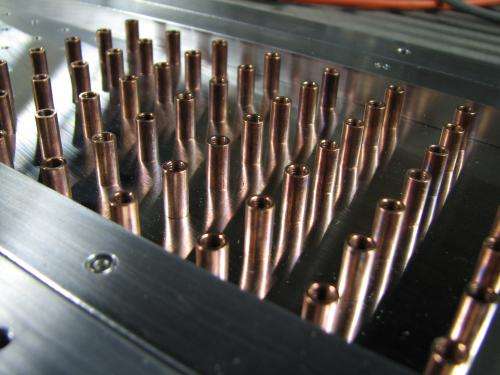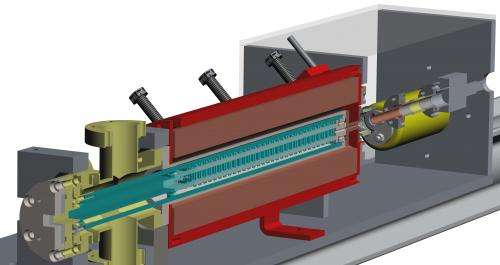Long-wavelength laser will be able to take medicine fingerprints

A laser capable of working in the terahertz range – that of long-wavelength light from the far infrared to 1 millimetre – enables the 'fingerprint' of, say, a drug to be examined better than can be done using chemical analysis. To achieve this, PhD student Thomas Denis of the University of Twente's MESA+ Institute for Nanotechnology has combined the best of two worlds, a free electron source and photonic crystals. The result: greater flexibility and a compact laser.
A terahertz laser is capable of showing the molecular structure of, say, a drug, because the laser beam it produces is at wavelengths suitable for examining molecular and atomic bonds. This enables more spatial information to be obtained than from chemical analysis, a detailed fingerprint. To date, however, the limitation has been that lasers of this type are restricted to particular wavelengths, e.g. because the source of the laser light is a semiconductor, in which electrons can only take on fixed energy states, hence only a limited number of 'colours' of light can be produced.
In a free electron laser the electrons are not restricted to fixed states, as are electrons in a classic cathode ray tube. So Denis thought, why not combine a free electron source with a 'photonic crystal'? This is a structure with lot of tiny 'posts' that together slow down the incident light and turn it into a coherent beam. Photonic crystals can be created at micro level, e.g. for a lab-on-a-chip, or on a much larger scale. The dimensions and shape of the crystal determine the rough wavelength region, and the precise wavelength can be set and adjusted by changing the speed of the electrons being fired at it. This combination is known as a 'photonic free-electron laser' or pFEL.

Existing terahertz lasers also have the disadvantage that they are very large, big enough to fill a room. Thanks to the use of photonic crystals the pFEL that Denis has designed is not much bigger than a domestic microwave oven and can still provide high power despite its small size. He has also found a special way of 'looking' inside a photonic crystal – something that is not normally possible. By interfering slightly with the wavelength pattern in the crystal using a tiny metal ball the actual pattern can be measured.
More information: Thomas Denis (Ahaus, 1981) received his PhD on 14 December for his thesis Theory and Design of Microwave Photonic Free-Electron Lasers. He carried out his research in Prof. Klaus Boller's Laser Physics and Non-linear Optics Group. The thesis, or the summary, is available in digital form on request.
Provided by University of Twente


















